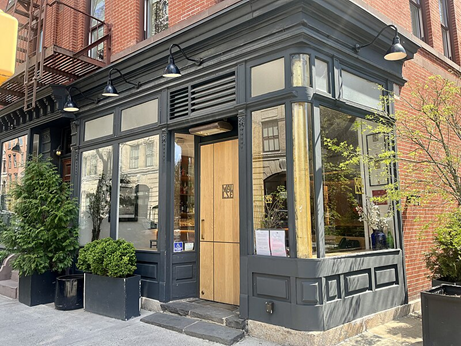The best way to get to know the wines of any section of Wine Country is to travel there and taste those wines in view of the vineyards. Essentially, that’s what Power Tasting is all about. But most of us don’t have the wherewithal to jet off around the globe, just to check out the latest trends and vintages.
So, you can go to your local shops and buy a bottle from a region you may have read about. There are a number of problems with that approach. You’re at the mercy of the distributors who supply that shop and may not have a good selection from the region you’re interested in. (Since this issue is focused on Austrian wines, let’s use that country as our example.) The wine store may have two Grüner Veltliners, a Blaufränkisch and that’s it. You don’t know too much about these wines either, so it’s a crap shoot that you’re not likely to win.
Wallse in New York, our favorite Austrian restaurant. Photo courtesy of Wikipedia.
Another alternative is to visit a restaurant that specializes in the food from the region you’re interested in. It surely has some of the wines you’re interested in and someone who knows a bit about them. But it’s not that straightforward, either. So here are a few tips for doing your wine tasting in a restaurant.
- Choose the right cuisine. This should be obvious, but it’s worth stressing. If you don’t enjoy the food, you probably won’t be thrilled with the wine either, no matter how well-chosen the list. So if wiener schnitzel and goulash aren’t your thing, maybe wine tasting in an Austrian restaurant won’t work out well for you.
- Sit at the bar. Even if you do like the cuisine, it’s a bit much to have to pay for a meal just to sample the wines. Most restaurants have a by-the-glass list; this is a good way to take a preliminary tour across the grapes and vintages that are made in the restaurant’s native country. There are some drawbacks to this approach, however. The wines on the by-the-glass list are generally not the best and are often among the least expensive of their types. So while you may taste a broader variety, you may not get to sample the qualities that are associated with a particular type of wine.
- Don’t taste alone. This is good advice for wine tasting in general, but where you’re interested in an introduction to the variety of a particular region, you shouldn’t be knocking back full glasses, much less whole bottles. Of course, those quantities are how restaurants sell wine, so if you’re with someone with whom you’re comfortable sharing, you’ll try more and drink less.
- Get help. If you don’t know anything about the wines or the labels, ask the sommelier or the bartender for the one wine that would serve as a good introduction to what that country produces. It’s a good question, not easy to answer. (Could you pick just one wine that typifies California, for instance?) The sommelier might be able to give you a few sips to help him or her understand your taste in wine, thereby giving you a broader sample right up front. More important, you’ll get your feet – er, your lips – wet right at the start.
- You can come back. If you find you like what you’ve tried, you can always dine or drink at that restaurant again. And if you are tasting at a restaurant far from home, you’ll have a basis for sampling at some other restaurant near you.
